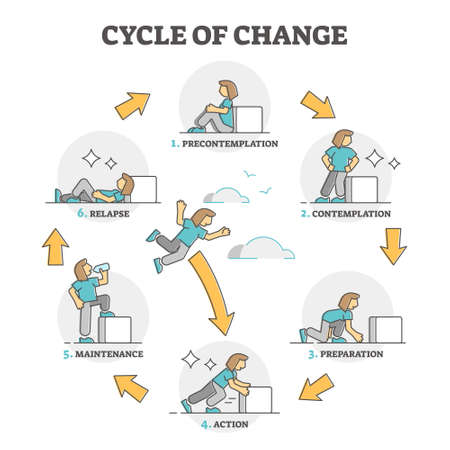
Lifestyle changes happen in stages. You don’t just wake up one morning and decide to make this huge, life-altering change. Even once you’ve made the decision, there’s more that happens after the decision is made. Change usually happens in stages and knowing what these stages are can be helpful to the process and how you make progress from getting where you are now to where you ultimately want to be.
Stage One: Pre-Contemplation
You may not think that being in denial could possibly be part of the process that will lead to a long-lasting behavioral change but that is where everything starts. During the first stage of change, you may not think your behavior is harmful to you or others. You may think, “It’s not really that bad.” Or “Others are making a big deal out of nothing.” That’s the reason the pre-contemplation step is often called being in denial.
Why do people deny that their behavior is harmful? There are a few possible reasons. They could resist acknowledging the consequences of their behavior simply because they don’t want to. Even when presented with facts and evidence, if someone doesn’t want to acknowledge something, they won’t; not even to themselves. The second reason could be they aren’t actually aware of the consequences. If you don’t know how bad a behavior is, you’re not going to think it’s all that bad.
The pre-contemplation stage is characterized by denying the problem or not understanding that it is a problem. So, what can you do during this stage to help you move on to the next stage?
If you’re aware of or are getting feedback that a behavior could be a potential risk to your health, start by:
- Thinking about the behavior and the feedback you’re getting.
- Reflect on what you are doing.
- Do some digging, there’s probably research and evidence your behavior is doing more harm than you may know about.
Stage Two: Contemplation
In the second stage of change, you start to really think about the consequences of your behavior. You may acknowledge that it’s worse than you’ve been trying to convince yourself and others it is. The problem here is that you may be weighing up the pros and cons of making that crucial change but you focusing on the negative impact of making that change.
When I say negative impact, I mean the discomfort it will cause you to make that change. When you’re altering your diet and physical activity level, you could think about how uncomfortable it would be to ditch old habits like emotional eating and the bodily discomfort of getting fit.
This stage is one of uncertainty. You think a change would be good but you’re not so sure you want to go through what it would take to make the change and make it stick. So many people don’t manage to progress past this point of contemplation. Actually, if you find yourself in this situation, you may have already been in it for weeks, months, or even years.
The contemplation stage is characterized by internal conflict and uncertainty. What can you do to help you make your way to the third stage?
- Do some introspection and consider a few very important questions:
- Why are you thinking about making a change? What are the benefits? What are the negative consequences if you don’t change?
- What, if anything, is stopping you from changing your behavior?
- What, if anything, could help to make the change happen or make it easier?
Stage Three: Preparation
When you reach this stage, your mind is pretty much made up. You know you want to change, why, and what the benefits will be but you’re not quite ready for a full-on lifestyle turnaround just yet. So, you’ll usually start testing the waters by making small changes to get yourself ready for the bigger ones to come.
You could prepare yourself by finding ways to implement the necessary behavioral changes, reading self-help books, looking for advice, etc. These are all characteristics of being in the preparation stage but what more can you do to get you to the next stage of the process?
Write down your goals and be specific about them, make them measurable, ensure they’re attainable, they must be relevant to you and what you want to achieve, and you need to set a time limit for reaching them.
- Come up with some personal affirmations that will remind you you’re making the right choice.
- Gather as much information as you can so you’re well-equipped for successfully implementing change. They say “Knowledge is power.” So is understanding. It’s not just about gathering generic information. You need to gain a deeper understanding of why you behave the way you do so you can understand how to change it and what obstacles to expect along the way.
Stage Four: Action

By this stage, you’re not just testing the waters anymore. You’re actively making change happen so you can work your way toward your goals. Many people think changes start here but they couldn’t be more wrong. It’s vital to grapple with and thoroughly move through and past the previous three stages. If you don’t, your actions will fall flat.
Don’t rush through stages two and three. I know you want to make a change now so you can see results sooner. However, not giving yourself enough time to contemplate, accept responsibility, and properly plan for change, simply jumping in on the deep end could see you drowning.
What can you do to prevent yourself from slipping backward during this stage?
- Take your time preparing to take action and arm yourself with the knowledge and resources you need to make a success of it.
- Look for support to buoy your motivation and resolve when uncertainty creeps in.
- Regularly go over your reasons for making a change, acknowledge the progress you’re making, and reward yourself for efforts and successes.
Stage Five: Maintenance
Ah, the maintenance stage. For a health and fitness lifestyle turnaround, this is the part where you’re reached your ultimate goals. You’ve lost weight, improved your health, and achieved the fitness level you dreamed of. Now it’s a case of keeping up the results but it’s not always as easy as it seems.
Once you’ve reached your goals, you’re done. You can sit back and put your lifestyle into cruise control but the moment you start getting lax is where the potential problems make an appearance. I’m talking about falling back into bad habits, becoming a victim of temptation, and not being vigilant enough to notice when your healthy habits start becoming less healthy.
It can happen to anyone and it does happen to a lot of people so how do you avoid your maintenance stage from slipping into relapse?
Understand your old lifestyle habits, the reasons behind them, and where your potential weaknesses are.
- Don’t underestimate getting “too comfortable”. Yes, you’re a new you but the past has the potential to replay itself.
- Check-in with yourself regularly to reflect on your behavior and ensure you’re not allowing temptation to get the better of you or old habits to take hold.
- Find and set new goals to strive toward to keep you growing instead of allowing yourself to stagnate.
Possible Stage Six: Relapse
Relapse doesn’t just mean someone picks up a substance abuse habit after being clean for a while. It describes any time you’re trying to kick a bad habit to the curb but you fall back into those old ways for some reason or another. As disappointing as they are, relapses are common and they’re characterized by:
- Blaming and shaming yourself for the relapse. You may even punish yourself for it but don’t do this, it’s not going to achieve anything except make you feel worse.
- Frustration and disappointment and feeling like you’re a failure.
Important steps to help you get back on track after relapse include:
- Acknowledge you are human and that relapses happen
- Avoid self-blame, convincing yourself you’re a failure, and self-punishment
- Pinpoint what is stopping you from achieving long-term success and what could be triggering your relapse behavior.
- Use affirmations to buoy your self-esteem and motivation.
- Go over your reasons for wanting to make a change, the progress you made, and how long you maintained your results before you relapsed.
- Seek social support.
- Come up with solutions to obstacles and ways to avoid triggers and temptation.
- Make sure you still have the resources you need to keep up with the change.
A Final Word
Making a change is a big deal and it’s more often than not pretty hard. The good news is that you can make a change and you can make it stick. You just need to move through the stages of change, taking your time with each one to set yourself up for success in the next stage. Be kind to yourself, don’t forget to reward yourself, and learn from your mistakes.
Sometimes people can go back and forth between stages and that’s normal. Maybe you started preparing for change but you may slip back into contemplation because preparing could feel intimidating and the change might suddenly seem overwhelming. That’s okay. The important thing to remember is to keep your eye on the prize and never give up.






